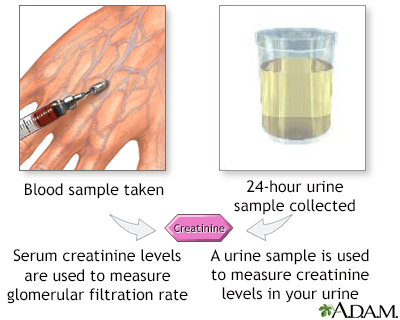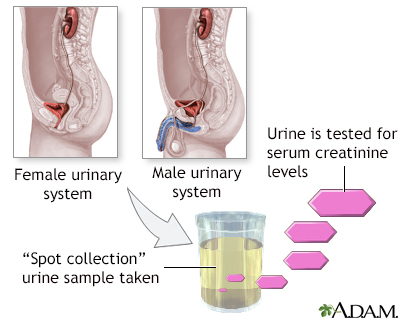Creatinine urine test
Definition
The creatinine urine test measures the amount of creatinine in urine. This test is done to see how well your kidneys are working.
Creatinine can also be measured by a blood test.
Alternative Names
Urine creatinine test
How the Test is Performed
After you provide a urine sample, it is tested in the lab. If needed, your doctor may ask you to collect your urine at home over 24 hours. Your health care provider will tell you how to do this. Follow instructions exactly so that the results are accurate.
How to Prepare for the Test
Your provider may tell you to temporarily stop taking certain medicines that may affect test results. Be sure to tell your provider about all the medicines you take. These include:
- Antibiotics such as cefoxitin or trimethoprim
- Cimetidine, famotidine, and ranitidine
DO NOT stop taking any medicine before talking to your provider.
How the Test will Feel
The test involves only normal urination. There is no discomfort.
Why the Test is Performed
Creatinine is a chemical waste product of creatine. Creatine is a chemical the body makes to supply energy, mainly to muscles.
This test is done to see how well your kidneys work. Creatinine is removed by the body entirely by the kidneys. If kidney function is not normal, creatinine level in your urine decreases.
This test can be used for the following:
- To evaluate how well the kidneys are working
- As part of the creatinine clearance test
- To provide information on other chemicals in the urine, such as albumin or protein
Normal Results
Urine creatinine (24-hour urine collection) values can range from 500 to 2000 mg/day (4,420 to 17,680 mmol/day). Results depend on your age and amount of lean body mass.
Another way of expressing the normal range for test results is:
- 14 to 26 mg per kg of body mass per day for men (123.8 to 229.8 µmol/kg/day)
- 11 to 20 mg per kg of body mass per day for women (97.2 to 176.8 µmol/kg/day)
Normal value ranges may vary slightly among different laboratories. Some labs use different measurements or test different samples. Talk to your provider about the meaning of your specific test results.
What Abnormal Results Mean
Abnormal results of urine creatinine may be due to any of the following:
- High meat diet
- Kidney problems, such as damage to the tubule cells
- Kidney failure
- Too little blood flow to the kidneys, causing damage to filtering units
- Kidney infection (pyelonephritis)
- Muscle breakdown (rhabdomyolysis), or loss of muscle tissue (myasthenia gravis)
- Urinary tract obstruction
Risks
There are no risks with this test.
Gallery




References
Landry DW, Bazari H. Approach to the patient with renal disease. In: Goldman L, Schafer AI, eds. Goldman-Cecil Medicine. 26th ed. Philadelphia, PA: Elsevier; 2020:chap 106.
Oh MS, Briefel G, Pincus MR. Evaluation of renal function, water, electrolytes, and acid-base balance. In: McPherson RA, Pincus MR, eds. Henry's Clinical Diagnosis and Management by Laboratory Methods. 24th ed. Philadelphia, PA: Elsevier; 2022:chap 15.